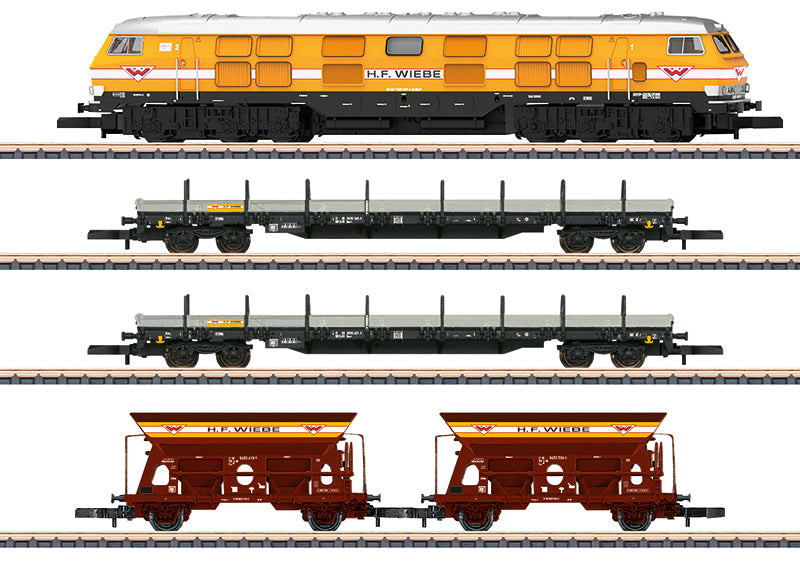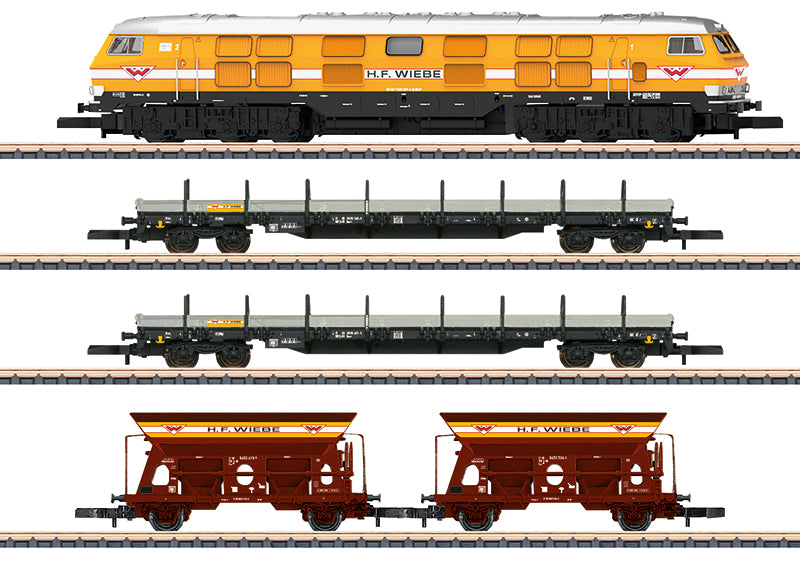Marklin 81320 - Wiebetrain Set with V320
Prototype: Diesel locomotive road number V 320 001-1 painted and lettered for the privately owned track laying company H.F. Wiebe. 2 DB AG type Fcs hopper dump cars and 2 DB AG type Res low side cars with promotional lettering for H.F. Wiebe. The locomotive and cars look as they do in Era VI.
Highlights
- Motor with a bell-shaped armature.
- Warm white LED headlights change over with the direction of travel to dual red LEDs.
- Frame constructed of metal and the body made of plastic.
- Engine room lighting and cab lighting.
- Engine room is modelled.
- Separately applied grab irons.
Product description
Locomotive model: The frame is constructed of metal and the body is made of plastic. Both trucks are powered. The locomotive has a motor with a bell-shaped armature. Triple warm white LED headlights change over with the direction of travel to dual red LEDs. The engine room is lighted and has imitation details. There is cab lighting. The level of detailing is high and includes an extensive, fine paint scheme and lettering. The locomotive has good pulling power due to its high weight. There are separately applied grab irons. The train has 2 type Res low side cars and 2 type Fcs hopper dump cars. The locomotive and cars are a special edition and are not available individually. Length over the buffers approximately 380 mm / 14-15/16".
Publications
- Fall New Items 2022Prototype information
As early as 1956, the firm Henschel began at its own cost design and construction in cooperation with the DB's central office in Munich of what is still the largest and most powerful diesel hydraulic locomotive in Europe. Henschel was able to reach back to valuable experience with export locomotives in the development of this giant. Apart from that, with road number V 320 001 use was made of the proven technique to install two 1,900 horsepower motors in this big unit from the newly built V 160. However, the three-axle trucks were completely new. In view of the maximum speed of 160 km/h / 100 mph, the wheelsets were given the unusually large diameter of 1,100 mm / 43-5/16".
A switching device activated, when the locomotive was stopped, allowed the assignment of the combination of high speed (160 km/h / 100 mph) with lower pulling power (express trains) or low speed (100 km/h / 63 mph) with higher pulling power (freight trains). The modern, angular design of its ends pointed the way for all future DB diesel locomotives. The proud 23 meter / 75 foot 5-1/2 inch length, the fat fuel tanks on the underside of the frame, and an impressive number of adjustable ventilation grills gave it a reptilian elegance behind which the two motor layouts hummed.
With its 122 metric tons of iron and steel distributed over six wheelsets, it could definitely be described as a monster – but a really beautiful monster! Due to high capacity utilization at Henschel, road number V 320 001 could not be delivered until 1962. Initially, extended measurement and test runs were done with the unit. Starting in 1963, it went into the DB roster as a lease locomotive and it was initially based at Hamm. In 1965, the class V 320 moved to Kempten and chiefly hauled heavy express trains between Munich and Lindau. There it quickly demonstrated how extremely suitable it was for heavy international express trains and the shop crews were full of praise for its performance reserves. The D 96 "Rhône-Isar" (Munich – Lindau – Zürich – Geneva) with a consist of usually eight cars formed one of its star trains. The DB as well as the SBB ran their latest rolling stock in it. The DB provided three types of the 26.4 meter / 86 foot 7-5/16" cars first bought in 1961/63, namely a type AB4üm-63 (compartment car, 1st/2nd class), two or three type B4üm-63 (compartment car, 2nd class), and a type BRbu4üm-61 half dining car (2nd class). The SBB reciprocated with its Mark I standard design cars (Mk 1) in lightweight steel construction with two type B cars (2nd class), a type A car (1st class), and a type D baggage car. In 1974, the DB ended the lease agreement with the class V 320 (starting in 1968: class 232) and gave it back to the builder. Henschel ran the unit through a major overhaul and sold it in April of 1976 to the Hersfeld County Railroad, where it was used until 1988. After that, the locomotive came to the Teutoburg Forest Railroad (TWE). After its deadline for maintenance came in 1992, it disappeared to Italy to earn its living in construction train service. This appeared to seal the fate of this highly interesting unit, but in 1999 came its spectacular importation back to Germany by the track construction firm WIEBE. After an extensive overhaul and the installation of new motors, it had been running since March of 2000 on German rails again, now designated as road number 320 001-1 (WIEBE 7), until wheelset bearing damage in 2015 ended its use forever. Since 2017, it has enriched the builder's plant in Kassel (now Bombardier) as a showpiece.
Features
Warning
EAN/UPC: 4001883813202



